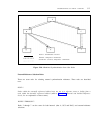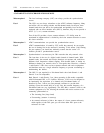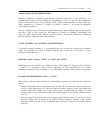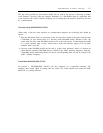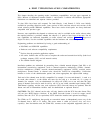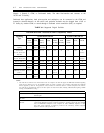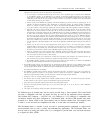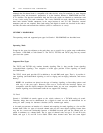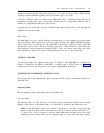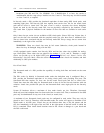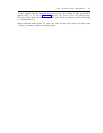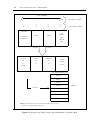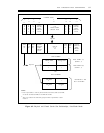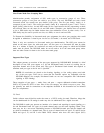
PORT TYPES/INSTALLATION COMPATIBILITIES
6-3
Application issues about the ANN11C and ANN11E are summarized below.
a.
It is not necessary to administer a DMI trunk type (108 or 109) or set the “Application Type” in procedure 260 to “DMI-BOS”
to use DMI-BOS signaling. To get DMI-BOS, use an ANN11E and administer 24th-channel signaling on the ANN11E by
setting field 8 in procedure 260 to 0. This causes ANN11E firmware to use the DMI-BOS signaling format for all trunk types
administered on that ANN11E. The only exception is where an ANN11E is connected to an ANN11C that is also administered
for 24th-channel signaling (see item c below).
b.
c.
d.
e.
f.
g.
ANN11E provides both DMI-BOS and proprietary 24th-channel signaling types. However, these two signaling types are not
selectable via ANN11E administration. When administered for 24th-channel signaling, the ANN11E defaults to DMI-BOS.
However, an ANN11E may still be connected to an ANN11C. The ANN11E will automatically determine when the ANN11C
(or any other endpoint) is using proprietary signaling and switch to proprietary 24th-channel signaling to maintain compatibility.
DMI trunk types 108 and 109 are intended for connections to DMI host computer endpoints and for ACCUNET switched
digital service. The primary difference of trunk types 108 and 109 is that they inhibit the use of “Data Answer tone” on the
trunk. Examples of applications requiring this are a DMI-BOS trunk to a host (which uses DMI-BOS 24th channel signaling) or
an ANN11 used for ACCUNET switched digital service access (which requires robbed-bit signaling). Again, trunk types 108
and 109 are not the only trunk types that can provide DMI-BOS signaling. This matters for “non host” DMI-BOS endpoints,
such as the IBM IDNX multiplexer. This multiplexer requires DMI-BOS 24th-channel signaling but is not a host. Therefore,
the ANN11E that terminates on an IDNX should be administered as any appropriate trunk type other than 108 or 109. Note
that, at present, DMIs are only certified for switch-to-host connectivity and not for switch-to-switch connectivity, which appears
to be the application of the IDNX multiplexer. This is now the only application of DMI that requires trunk types other than 108
or 109.
ANN11C may be used in any R2 switch supporting DS1 trunks. However, there is one caveat that applies to switches
supporting DMI host trunk types 108 & 109 (System 85 R2V3 and later). If the ANN11C is administered for 24th-channel
signaling, it will use the proprietary type. This means that it will work as long as it is connected to a System 75 or System 85
but will not work if connected to another vendor’s DMI-BOS endpoint using trunk type 108 or 109.
Setting the “Application Type” field of procedure 260 to “DMI-BOS” prevents the associated ANN11 board from being used as
a clock reference by a system clock synchronizer. This is only useful when the ANN11 connects to a host. Here, the host loop
times to the switch and cannot be used as a clock reference.
2.
3.
4.
5.
6.
7.
8.
An ANN11D is equivalent to an ANN11E. The E suffix came from adding a fiber interface to the ANN11D. However, the
fiber connectivity was not pursued. ANN11Ds were produced in limited numbers for System 85 R2V4.
The DMI-BOS signaling supported by ANN11E from System 85 R2V3 and later should not be confused with DMI-MOS
supported by ANN35 (Primary Rate Interface) from System 85 R2V4 and later.
The TN380B (module processor) and ANN11B (DS1) are manufacture discontinued (MD) and are not available for R2V3 or later
versions. For duplicated modules, both modules must always be equipped with the same type of module processor; both modules
must be equipped with the TN380C or TN380D circuit packs. (TN380D supersedes TN380C and earlier in ISCN 249DR.)
The TN580 has all functions of the TN380D.
The DMI-BOS is available with the ANN11D, ANN11E, and TN722B circuit packs. The ANN11D is only used on some R2V4 CIs.
The ANN11E supersedes the ANN11C as the production model. For System 85 and Generic 2, DMI-MOS is available with the
ANN35 circuit pack (traditional modules) and with the TN767 or TN755 circuit pack (universal modules).
For Generic 1, DS1, CO, & foreign exchange (FX) with TN767.
The OPS line option is initially available with the TN380C, TN380D, ANN11C, ANN11D, and ANN11E circuit packs. Therefore,
the R2V3 software (or later version) is required for administration purposes (procedure 000).
System 85 R2V3 for analog DSC endpoints; System 85 R2V4 for added digital endpoints.
The dynamic trunk group includes CO trunk types (17, 27, and 30), tie trunk types (41, 42, 43, 46, and 47), as well as DMI trunk
types (108 and 109).
This requires an accompanying TN555 circuit pack to terminate the D-channel.
Six different types of channel units may be used to provide drop or insert channels. The 4-wire E&M
tie trunk is compatible with DS1 tie trunks and may be used for the dedicated switch connection.
The All-Rate OCU Dataport — RS-232C (2.4, 4.8, 9.6K-bps) or V.35 (56K-bps) is compatible with
an identical channel unit when configured in a D4-channel bank. All other CDM channel units must
terminate at a distant CDM on the same channel with an identical channel unit. The emphasis here
is what is on one end must be compatible with what is on the other end, channel per channel.
The D4-channel bank is versatile. It may be used as customer-premises equipment to support both
circuit-switched (such as with a switch) and dedicated-line applications. The D4-channel banks can
also be used at an analog end office (class 5) or configured to provide both voice and data interfaces
to a digital toll office (4ESS).



